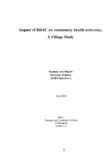| dc.contributor.author | Begum, Shamim Ara | |
| dc.contributor.author | Hannan, Rowshan | |
| dc.contributor.author | Chowdhury, AMR | |
| dc.date.accessioned | 2019-11-20T05:09:08Z | |
| dc.date.available | 2019-11-20T05:09:08Z | |
| dc.date.issued | 2001-07 | |
| dc.identifier.citation | Begum, S. A., Hannan, R., & Chowdhury, A. (2001, July). Impact of BRAC on community health networks: a village study. Research Reports (2001): Health Studies, Vol - XXX, 1–26. | en_US |
| dc.identifier.uri | http://hdl.handle.net/10361/13023 | |
| dc.description.abstract | Mere health service provision may be unable to bring about the desired impacts on health
outcomes. Such outcome impact is mediated by changes in health seeking behavior
underpinned by changes in health kr!Owledge, attitude and practice---variables which are
socially embedded and transmitted through networks. BRAC, the largest national NGO in
the world, in an effort to provide cost-effective and mass scale essential health service
coverage in rural areas, makes use of locally recruited community health workers-shasthya
shebikas.
This study attempts to describe the health network in a village where the shebika has been
working for many years. It has tried to assess the past health network in the village and
how the introduction of a shebika has influenced this network. It also examines the power
and influence of the shebikas in a village, and how this influence has changed over time.
The study finds that far from polarising the village between members and non-members
the shebikas are actually consulted by a range of people. Thus it can be said that the
health network in the village, which is dominated by the shebikas have created an
inclusive health network of different NGO and non-NGO members. After ten years of
BRAC's Mainstream Health Programme in the study village we found that the shebikas
reached a large and inclusive group transcending social and wealth categories. This is
even more encouraging in view of the fact that the shebikas come from the lowest wealth
category. Though only six percent of the households did not visit any health practitioner
at all, they were noted to include some of the poorest in the village, suffering from
exclusion from multiple networks. Future research should explore the pathways through
which such exclusions happen and the general interlinkages between health and other
socio-economic networks. | en_US |
| dc.language.iso | en | en_US |
| dc.publisher | BRAC Research and Evaluation Division (RED) | en_US |
| dc.subject | BRAC | en_US |
| dc.subject | Community health | en_US |
| dc.subject | Health programme | en_US |
| dc.subject | NGO | en_US |
| dc.subject.lcsh | Public health | |
| dc.subject.lcsh | Community health services | |
| dc.subject.lcsh | Health, Nutrition, and Population Program (BRAC) | |
| dc.title | Impact of BRAC on community health networks: a village study | en_US |
| dc.type | Research report | en_US |

